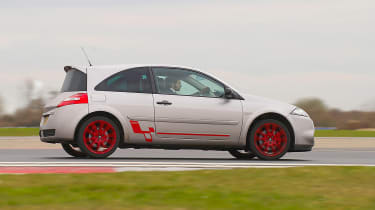The Renaultsport Megane R26.R's polycarbonate windows - Art of Speed
It's almost impossible to pass an R26.R and not prod its polycarbonate rear window. Here's what makes it special

One imagines Jean-Pascal Dauce, dismayed at having had his request to give the forthcoming phase two Renaultsport Mégane R26 a power hike curiously denied, felt a lump form in his throat. After all, it being 2007, his counterpart at Ford – none other than Jost Capito – was in the process of arming a new Focus RS with a reported 300bhp and a chassis capable of handling it…
In hindsight, the man behind any Mégane worth driving had sound grounds on which to ask the Groupe Renault board for a right of reply, because at a time when the hot hatch power wars were threatening to go nuclear, the R26’s existing 227bhp wasn’t going to be enough to carry the new car. What that seemingly apathetic rejection forced Dauce and his engineers to do, however, will go down in automotive legend.
At 1345kg, the R26 was not a particularly heavy car and had even been described in these very pages as ‘the ultimate hardcore fast hatch’, yet after Dauce’s men stripped it down to a carcass and replaced what they couldn’t remove with lighter alternatives, what was left was the R26.R.
> Renaultsport Megane R26.R (2009) review - an all-time great hot hatch
There must have been an whiff of mania during product planning meetings for the R26.R – amusingly, Dauce later admitted that things did in fact get a bit out of hand – because out went the rear seats, passenger and curtain airbags, climate control, rear-window and headlamp washers, and the radio and CD player. With any pretence of practicality laughed aside, there was also a ruthless cleansing of soundproofing materials. Of what remained, the seats were exchanged for carbon-shelled Sabelt pieces with six-point harnesses and aluminium bases and the bonnet was swapped for a carbon piece that itself was an objet d’art. A roll-cage and titanium exhaust also featured, if so optioned.
Overall, 123kg evaporated and the car’s all-important power-to-weight ratio rose from 171 to 189bhp/ton – the equivalent of giving the original R26 a robust and very competitive 250bhp.
One detail illustrates the R26.R’s motorsport-inspired madness better than any other, though: polycarbonate rear and rear side windows. Renaultsport saved 5.7kg by ditching glass and it’s this deliciously melodramatic detail everyone remembers. One window also bears a graphic celebrating test driver Vincent Baylé’s committed 8min 17sec Nürburgring effort. Perhaps easier to appreciate, however, is that this 911 GT3 RS-lite went on to lap the West Circuit at Bedford Autodrome in the same time as a BMW M3 CSL, a fact that’s still hard to comprehend.


